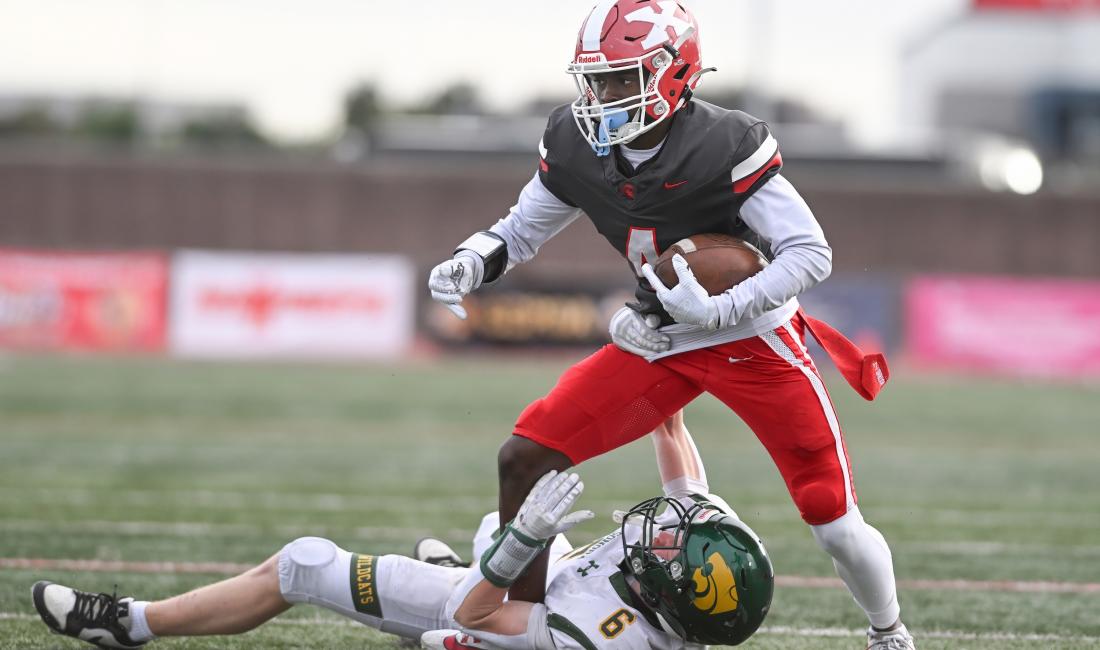A high school team lost 9 of its 10 regular season games. Then, under an equity system, it won a championship.
This column is co-published with Zócalo Public Square. Photo credit: Marc Geretz
In their football season opener, St. Pius X-St. Matthias Academy, a Catholic school in Downey in southeast Los Angeles county, lost to Buchanan High (of Clovis) 38-0.
The next week, the Warriors fell 56-14 to Crean Lutheran of Irvine. Six consecuetive losses followed before St. Pius X-St. Matthias notched its first win. But then in their regular season finale, the Warriors were blasted by St. Francis of La Cañada-Flintridge, 35-14.
After finishing with a 1-9 record, Warriors players and coaches thought their season was ove
Except it wasn’t.
Instead, the California Interscholastic Federation (CIF) awarded St. Pius X-Matthias Academy an at-large berth in the Division 8 football playoffs for the Southern Section (covering L.A., Orange, Ventura, Riverside and San Bernardino counties). Given a second life, the team ran off five consecutive victories and advanced to a state championship game last Saturday.
How did this happen? The answer lies in a peculiar California application of a popular and controversial word:
Equity.
Equity is the most powerful of the three values embodied in Diversity, Equity and Inclusion, or DEI. Equity is also controversial. Because it goes beyond equality—treating people all the same—to seeking fairness in outcomes. Because it demands disrupting existing systems and traditions to achieve fairness. And because it’s hard to people to agree on what’s fair.
The difficulties of achieving equity have fueled a fierce backlash, and the rollback of DEI programs in universities and workplaces. But intriguingly, the quest for equity is alive and advancing in California high school sports.
In this century, “competitive equity” has become a central principle of CIF, the high schools sports governing body in California. Most important, competitive equity guides how CIF places schools in post-season football and basketball playoffs.
California has long been too big to include its high schools into a single state or even regional championship tournament. So, for the state’s two most popular sports, football and basketball, CIF organizes its teams into divisions for playoffs. In each division, all schools are supposed to be on the same competitive level.
Except they rarely were, before competitive equity.
Why not? Because divisions were based on factors other than team performance. One such factor was student enrollment. For decades (including when your columnist was playing CIF baseball in the 1990s), divisions were based on school size. But school enrollment wasn’t a good proxy for sports excellence. Smaller private schools with wealthy athletic boosters could build programs far stronger than those of many big, budget-stretched public schools.
At other times, divisions were based on geographic proximity—on the theory that schools from the same area would have similar talents. But as some high school programs started recruiting far-flung star players to create super-teams, that didn’t work, either. Indeed, over 15,000 students transfer for athletics each year.
Playoff tournaments so often produced blowouts that, in the early 2010s, CIF officials concluded that the best way to make division playoffs fair was to use a rankings system for all high school teams. Schools with similar rankings would be placed in the same division.
CIF called this new system “competitive equity.” It drew complaints from traditionalists, who preferred the old, established divisions based on enrollment. The first “competitive equity” formula received criticism for placing teams in divisions at the beginning of the season on the basis of their performance in the previous two years. In sports, the past is not prologue; high school teams change dramatically each year as first-year students arrive, and seniors graduate.
Eventually, CIF corrected the system to rank teams only on their current season play. CIF waits until after the final regular season rankings to place teams in divisions for playoffs. So each post-season, different teams are in different divisions. The resulting playoffs are full of strange outcomes and surprises.
None more surprising than St. Pius X-St. Matthias this year.
The Warriors made the playoffs because the competitive equity rankings count not just wins and losses, but strength of schedule. And St. Pius X-St. Matthias faced an unusually strong group of opponents; nine of the ten teams they played in the regular season qualified for the playoffs.
As a result, the Warriors ranked high enough in the competitive equity system to be considered for the eighth-highest division out of the 14 playoff divisions in the Southern Section. But they had a losing record, so they had to be lucky to get a spot.
When the CIF creates a division, it first includes all the automatic playoff qualifiers—teams that finished first in their leagues. It then uses competitive equity rankings to add in other schools that had records of .500 or better. But in Division 8, there weren’t enough automatic qualifiers and at-large teams with .500-or-better records to fill the 16-team field.
So St. Pius, with its strong ranking, got a spot. In the playoffs, the young Warriors team grew up—led by two juniors, quarterback Jassi Williams and two-way star Demari Nunley.
The Warriors weren’t the only losing team in the playoffs. In fact, after winning four games to take the Southern Section championship, they played the San Diego section champion, St. Augustine, in the regional final. St. Augustine had a worse record than the Warriors. The Saints lost all 10 regular season games, but they also had a brutal schedule that won them a playoff spot under the competitive equity system.
A regional final between two teams with a combined regular season record of 1-19 drew national media scrutiny, including from Sports Illustrated and FOX Sports. Warriors coach Devah Thomas acknowledged the strangeness. “I don't make the rules, I just follow them. They want competitive equity,” he told former USC star-turned-pocaster Keyshawn Johnson. “We fit the criteria.”
The Warriors’ magical run ended in the state championship game with a 52-34 loss to the 12-2 Sonora High School Wildcats, from a small town in Tuolumne County.
But competitive equity’s winning streak continues. This school year, the CIF Southern Section extended competitive equity beyond football and basketball to playoffs in all sports. And the critics didn’t complain.
Why not? Maybe that’s because this is sports, where equity creates entertaining games, rather than human resources edicts. Or maybe it’s just easier to see in the Warriors’ season what equity was supposed to do all along: give the people who faced tougher opposition a fair chance to be champions.




